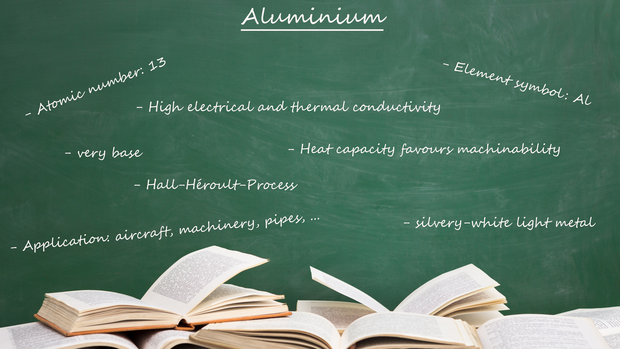Aluminium is a chemical element identified by the atomic number 13 and the element symbol "AI".
If you look at it in relation to the other elements within the Earth's shell, aluminium is the third most common element
after oxygen and silicon. Because aluminium is so versatile,there are numerous aluminium compounds.
Properties of aluminium
Aluminium is a silvery-white light metal. The term "aluminium" is used to describe all materials that are based on the element aluminium.
It is irrelevant whether the material is pure aluminium (at least 99.0% aluminium) or ultra-pure aluminium (at least 99.7%).
However, the aluminium alloy has the head in front, as it can almost be compared to the strength of steel -
even though it has only one third of the density. The metal aluminium is very base and therefore reacts with air and water when freshly cut.
As a result, at normal room temperature, aluminium very quickly turns into aluminium oxide. The purpose behind this is to protect the metal from corrosion.
Because aluminium reacts so quickly, a thin layer forms over the aluminium that is impermeable to air and water. However, if aluminium is in its pure state,
it has a low strength, which only increases in strength when alloyed. Furthermore, aluminium has a high electrical and thermal conductivity and
is therefore often used as cables and heat exchangers. Due to its high thermal conductivity and heat capacity, it is easy to machine and
use high cutting speeds, for example when milling or turning.
In nature, aluminium occurs mainly in a chemical form. It was not until the early 20th century that industrial mass production of this material began.
So how is this material obtained? Most materials have their place of origin in a so-called aluminium smelter, where pure aluminium is obtained through fused-salt electrolysis. In combination with the mineral bauxite, aluminium oxide can now be obtained. Subsequently, aluminium is extracted through fused-salt electrolysis using the Hall-Héroult process.
Probably the best-known product made of aluminium is aluminium foil, which is part of the standard inventory in every household. However, aluminium can also be used outside the four walls. For example, the precious metal is also used in components of aircraft, machines or pipes and electrical cables. Aluminium is very versatile in its application.
But other materials such as plastic and copper can also be used in multiple applications.
Do you currently have the desire to produce a component from aluminium, but lack the possibilities?
Send us an enquiry. All you have to do is upload your drawing to PART FACTORY,
specify a quantity and we will get back to you with an offer in line with the market.
Try contract manufacturing through our B2B contract manufacturing portal and submit an enquiry today.


